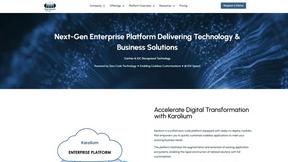Best Development tools (17+)
Discover 17+ best development tools. Compare features, pricing, and reviews. Free and paid options available.
diffray
AI code review with 30+ specialized agents. Catches real bugs, not nitpicks. 87% fewer false positives than single-agent tools.
CloudBurn
Get automatic AWS cost estimates in your pull requests. Prevent expensive infrastructure mistakes before deploying to production.
Free Sora Generator
No Pay & No Credit Card & Need Login
DeepRails
AI guardrails that hyper-accurately detect and fix hallucinations in LLM-powered applications.
Mapfirst.ai
Mapfirst.ai is a fully interactive map, similar to Google maps SDK, but it's completely free, with the option to add a monetization layer.
Shadcn UI Kit
A large collection of admin dashboards, website templates, UI components, and ready-to-use blocks. Save time and deliver projects faster.
TemplateCat
TemplateCat is a cute little cat which helps you filter website templates designed by professionals from all over the web.
Agenta
Agenta is an open-source LLMOps platform for building reliable AI apps. Manage prompts, run evaluations, and debug traces with your team.
Stunning
Stunning is the fastest Vibe coding platform with Backend and Database built-in.
Giga AI
Make complex apps easily, with a smarter AI that remembers your decisions, manages context, and helps you plan and build
Recall.ai
Recall.ai provides a single API to get recordings, transcription and metadata from virtual and in-person meetings.
900.cool 静态网站托管
900.cool offers a professional static website hosting platform for instant deployment of HTML, CSS, and JavaScript files with custom domains.
Dreamflow
Prompt with AI, refine UI visually, or go deep in code. The 3 surfaces stay connected, giving you speed, flexibility, and code you can own.
Mod
Mod is a CSS framework for SaaS apps featuring a growing library of components for shipping SaaS UI fast.
Activepieces
Open-source AI Agent ecosystem for building smart agents with zero code. Easy for non-tech users, flexible for devs, built to automate anything.
Claude Fast
Claude Fast supercharges Claude Code with 6x context, smart agents, and workflows.
FAQs for Development
How do tools in the Development Category enhance developer productivity?
Tools in the Development Category enhance developer productivity by providing resources that automate repetitive tasks, streamline coding processes, and facilitate better collaboration. These tools enable developers to focus on critical areas, reduce downtime, and deliver high-quality software products more efficiently, addressing common challenges faced in development projects.
What unique features do Integrated Development Environments offer in the Development Category?
Integrated Development Environments (IDEs) in the Development Category offer unique features such as code completion, debugging tools, and seamless integration with version control systems. These functionalities enhance coding efficiency, simplify project management, and improve overall software quality by ensuring that developers have everything they need in one accessible platform.
In what scenarios are Version Control Systems most beneficial within the Development Category?
Version Control Systems are most beneficial in scenarios involving teamwork on software projects, where multiple developers contribute code. They allow teams to manage code changes effectively, prevent conflicts, and maintain a reliable history of project iterations. This ensures that all members can collaborate without losing progress or compromising project integrity.
What makes Automated Workflow Management a competitive advantage in development?
Automated Workflow Management provides a competitive advantage by significantly reducing the time spent on manual, repetitive tasks. This efficiency enables developers to allocate more effort towards innovation and problem-solving. By streamlining project timelines and enhancing collaboration, businesses can bring products to market faster while maintaining high-quality standards.
How do tools in the Development Category adapt to changing technology needs?
Tools in the Development Category adapt to changing technology needs by regularly updating features and incorporating the latest advancements. This ensures that developers have access to innovative solutions that meet contemporary demands, ultimately improving their ability to create robust software solutions that respond to evolving market conditions and user requirements.
How do Integrated Development Environments support collaborative software development?
Integrated Development Environments support collaborative software development by providing shared tools that enable developers to work together seamlessly. Features like code sharing, real-time editing, and integrated communication channels make it easy for teams to coordinate their efforts, track progress, and ensure that everyone is aligned on project goals.
You may also like
Photography
The Photography Category connects photographers with AI tools that optimize workflows and enhance creativity.
Meeting & Scheduling
The Meeting & Scheduling Category offers efficient tools for optimizing appointments and increasing productivity.
Copywriting
The Copywriting Category focuses on persuasive content creation, enhancing engagement and conversions.
Knowledge Management
The Knowledge Management Category streamlines knowledge sharing for better collaboration and decision-making.
Customer Support
The Customer Support Category streamlines support interactions, enhancing satisfaction through targeted assistance.
HR & Recruiting
The HR & Recruiting Category offers AI solutions to enhance hiring efficiency and improve talent acquisition.
Marketing
The Marketing Category simplifies digital campaigns, offering essential tools for marketers.
Payments
The Payments Category features advanced AI payment solutions for secure, efficient transactions.

















